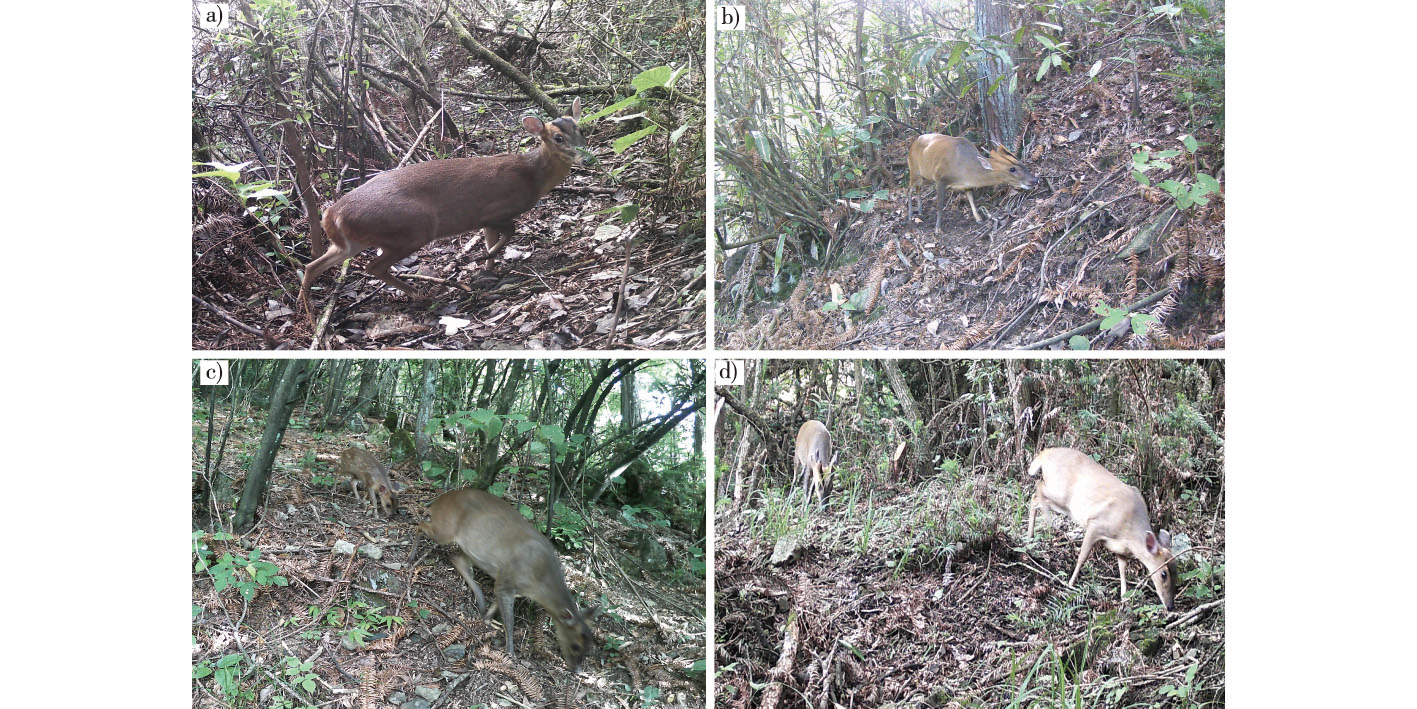 PDF(5490 KB)
PDF(5490 KB)


浙江绿葱湖省级湿地公园小麂活动节律和集群行为研究
张文旭, 林晓越, 毛岭峰, 伊理孝, 李垚, 应建平, 唐超和
南京林业大学学报(自然科学版) ›› 2024, Vol. 48 ›› Issue (1) : 81-87.
 PDF(5490 KB)
PDF(5490 KB)
 PDF(5490 KB)
PDF(5490 KB)
浙江绿葱湖省级湿地公园小麂活动节律和集群行为研究
Activity rhythm and clustering behavior of Reeve’s muntjac (Muntiacus reevesi) in Lüconghu Provincial Wetland Park of Zhejiang Province
【目的】对浙江绿葱湖湿地公园内人为活动干扰下小麂(Muntiacus reevesi)种群的活动节律和集群模式进行研究,为有蹄类动物的科学保护与管理提供依据。【方法】利用红外相机于2021年2月—2022年1月对该地区小麂种群开展连续监测,基于1 896张独立有效照片分析其日活动节律和集群模式。【结果】小麂的日活动节律存在季节性差异。其中,冬季与春季的日活动节律曲线重叠度(Δ)最低(Δ = 0.79,P <0.01),小麂在冬季傍晚的活动强度高并且峰值也明显提前。不同海拔梯度的小麂日活动节律也存在差异。其中,海拔[700,900)m与[1 100,1 300)m的日活动节律曲线重叠度最低(Δ = 0.76,P <0.01),海拔[700,900)m的小麂只有傍晚1个活动高峰。本次监测共发现7种集群模式,其中最高的为单只独居,占比达92.95%;其次是母仔群,占比3.47%;再次是1雌1雄群,占比2.37%;其余4种(双雌、双雄、1雄1幼、2雌1幼)少见的集群模式共占比1.21%。【结论】在浙江绿葱湖省级湿地公园内,小麂是以晨昏活动为主的昼行性动物,主要营独居生活。其日活动节律在不同季节、不同海拔梯度表现出明显的差异,可能主要受温度、食物资源、植被类型和人为干扰等因素影响。
【Objective】We aim to reveal the activity rhythms and clustering patterns of the Reeve’s muntjac (Muntiacus reevesi) population under anthropogenic disturbance in Lüconghu Provincial Wetland Park of Zhejiang Province, to provide a basis for the scientific conservation and management of ungulates.【Method】We used infrared camera trapping to monitor the population of M. reevesi from February 2021 to January 2022. The daily activity rhythm and group patterns were analyzed based on the data from 1 896 independent valid photos.【Result】 The daily activity rhythms of M. reevesi varied across seasons. The minimum area of the overlap of daily activity rhythm curves (DARCs) was observed between winter and spring (Δ = 0.79, P<0.01), with higher intensity and significantly earlier activity peaks detected in the dusk of winter. The daily activity rhythms of M. reevesi also differed along altitudinal gradients. The minimum area of the overlap of DARCs was found between 700-900 m and 1 100-1 300 m (Δ = 0.76, P <0.01), with only one peak of activity detected in the dusk at 700-900 m. Seven group patterns were identified. The solitary individual pattern had the highest proportion (92.95%), followed by the adult female with fawn group (3.47%) and one female and one male group (2.37%). The remaining four group patterns (two female, two male, one male with fawn, two female with fawn) only accounted for 1.21% of the valid detections in this study.【Conclusion】The M. reevesi in Lüconghu Provincial Wetland Park of Zhejiang Province, is a diurnal animal mainly active in the morning and dusk and is mainly solitary. Its daily activity rhythm showed significant differences in different seasons and altitude gradients, which may be mainly influenced by factors such as temperature, food resources, vegetation type, and human disturbance.

小麂 / 有蹄类 / 日活动节律 / 集群模式 / 红外相机
Reeve’s muntjac (Muntiacus reevesi) / ungulate / daily activity pattern / group pattern / infrared camera
| [1] |
原宝东, 孔繁繁. 哺乳动物活动节律研究进展[J]. 安徽农业科学, 2011, 39(2):1056-1058,1162.
|
| [2] |
孙儒泳. 动物生态学原理.[M]. 3版. 北京: 北京师范大学出版社, 2001.
|
| [3] |
龙帅, 周材权, 王维奎, 等. 矮岩羊夏季活动节律、时间分配和集群行为[J]. 动物学研究, 2009, 30(6):687-693.
|
| [4] |
孙佳欣, 李佳琦, 万雅琼, 等. 四川9种有蹄类动物夏秋季活动节律研究[J]. 生态与农村环境学报, 2018, 34(11):1003-1009.
|
| [5] |
|
| [6] |
|
| [7] |
冯晓娟, 米湘成, 肖治术, 等. 中国生物多样性监测与研究网络建设及进展[J]. 中国科学院院刊, 2019, 34(12):1389-1398.
|
| [8] |
李勤, 邬建国, 寇晓军, 等. 相机陷阱在野生动物种群生态学中的应用[J]. 应用生态学报, 2013, 24(4):947-955.
|
| [9] |
|
| [10] |
章书声, 鲍毅新, 王艳妮, 等. 基于红外相机技术的黑麂活动节律[J]. 兽类学报, 2012, 32(4):368-372.
|
| [11] |
温立嘉, 郭玉民, 黄建, 等. 帚尾豪猪活动节律及其与月光周期的相关性[J]. 动物学杂志, 2016, 51(3):347-352.
|
| [12] |
冯茜, 胡强, 施小刚, 等. 卧龙国家级自然保护区红腹角雉适宜栖息地与活动节律研究[J]. 四川林业科技, 2021, 42(4):12-19.
|
| [13] |
余建平, 钱海源, 陈小南, 等. 基于红外相机技术的白鹇日活动节律研究[J]. 动物学杂志, 2017, 52(6):937-944.
|
| [14] |
盛和林, 陆厚基. 我国亚热带和热带地区的鹿科动物资源[J]. 华东师范大学学报(自然科学版), 1985(1):96-104.
|
| [15] |
盛和林. 中国鹿类动物[M]. 上海: 华东师范大学出版社,1992.
|
| [16] |
鲁庆彬, 于江傲, 高欣, 等. 冬季清凉峰山区小麂和野猪的生境选择及差异[J]. 兽类学报, 2007, 27(1):45-52.
|
| [17] |
董聿茂. 浙江动物志-兽类[M]. 杭州: 浙江科学技术出版社,1989.
|
| [18] |
盛和林, 王培潮. 小麂的生态和利用[J]. 动物学杂志, 1976, 11(1):39-40.
|
| [19] |
杨婵, 万雅琼, 黄小富, 等. 基于红外相机技术的小麂(Muntiacus reevesi)活动节律[J]. 广西师范大学学报(自然科学版), 2021, 39(1):65-70.
|
| [20] |
余建平, 陈小南, 任鹏, 等. 基于样线法和非损伤性标志重捕法对古田山小麂种群现状评价[J]. 兽类学报, 2017, 37(4):354-362.
|
| [21] |
肖治术, 李欣海, 王学志, 等. 探讨我国森林野生动物红外相机监测规范[J]. 生物多样性, 2014, 22(6):704-711.
|
| [22] |
|
| [23] |
|
| [24] |
陈立军, 束祖飞, 肖治术. 应用红外相机数据研究动物活动节律:以广东车八岭保护区鸡形目鸟类为例[J]. 生物多样性, 2019, 27(3):266-272.
|
| [25] |
|
| [26] |
|
| [27] |
陈尔骏, 官天培, 李晟. 四川岷山小麂的种群性比、社会结构和活动节律[J]. 兽类学报, 2022, 42(1):1-11.
|
| [28] |
贾晓东, 刘雪华, 杨兴中, 等. 利用红外相机技术分析秦岭有蹄类动物活动节律的季节性差异[J]. 生物多样性, 2014, 22(6):737-745.
|
| [29] |
赵晨光, 何明超, 苏晋芬, 等. 基于红外相机技术对中华斑羚活动节律的研究[J]. 野生动物学报, 2022, 43(1):32-37.
|
| [30] |
刘明星, 朱必清, 王语洁, 等. 四川白河国家级自然保护区毛冠鹿(Elaphodus cephalophus)活动节律及季节变化[J]. 四川林业科技, 2021, 42(2):27-32.
|
| [31] |
官天培, 龚明昊, 胡婧, 等. 小麂秋季利用人工盐场的节律[J]. 动物学杂志, 2015, 50(2):169-175.
|
| [32] |
刘振生, 李新庆, 王小明, 等. 贺兰山岩羊(Pseudois nayaur)集群特征的季节变化[J]. 生态学报, 2009, 29(6):2782-2788.
|
| [33] |
黄沛琳, 肖文宏, 杨海涛, 等. 东北梅花鹿种群活动节律和集群行为研究[J]. 北京师范大学学报(自然科学版), 2015, 51(5):498-503.
|
/
| 〈 |
|
〉 |